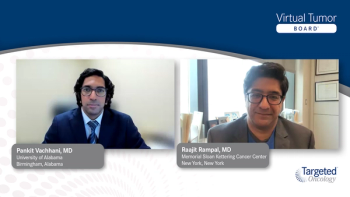
Graft versus Host Disease Background
A panel of experts discusses the types of graft versus host disease and the biologic pathways that are thought to be involved.
Episodes in this series

Transcript:
Yi-Bin Chen, MD: Thank you for joining us for this Targeted Oncology™ Virtual Tumor Board®, titled “Perspectives on the Management of Chronic GVHD.” In today’s presentation, my colleagues and I will review 2 clinical cases. We’ll discuss approaches to treating patients with GVHD [graft-vs-host disease], and we’ll share our perspectives on key clinical trial data that may impact our decisions. My name is Yi-Bin Chen. I direct the transplant program at Massachusetts General Hospital [in Boston]. Today I’m joined by Corey Cutler, Colleen Danielson, and Catherine Lee. I’d like to take a second so that everyone can introduce themselves. Corey, go ahead.
Corey S. Cutler, MD, MPH, FRCPC: I’m Corey Cutler. I’m the director of the stem cell transplant program at the Dana-Farber Cancer Institute in Boston [Massachusetts].
Yi-Bin Chen, MD: Colleen?
Colleen Danielson, NP: I’m Colleen Danielson. I’m a nurse practitioner with the bone marrow transplant team at Mass General Hospital in Boston.
Yi-Bin Chen, MD: Catherine?
Catherine J. Lee, MD, MS: My name is Catherine Lee, and I’m an associate professor. I recently joined the Fred Hutchinson Cancer Center in Seattle, Washington.
Yi-Bin Chen, MD: Thanks for joining us, everyone. Let’s get started. Let’s set the table with graft-vs-host disease and a little background. To do that, we have to think about why we do allogeneic transplants to begin with. All of us would agree that the primary reason we do an allogeneic transplant for the vast majority of hematologic malignancies is for curative intent. The main mechanism of action that drives that potential curative intent would be something called graft-vs-leukemia or graft-vs-malignancy effect. This is an immunologically driven effect, where donor cells in the recipient are able to eradicate any residual malignancy left through an immunological reaction. As much as we expect those white blood cells to fight infection, we also expect them to keep the host tumor away for good. The issue is that sometimes after a transplant, donor cells attack not only the residual host malignancy but also the healthy body. That’s where we see graft-vs-host disease, where healthy donor cells are attacking the host’s healthy body. This leads to GVHD, which many of us have spent our careers trying to prevent or treat or to improve the lives of our patients afflicted with such.
There are 2 versions of graft-vs-host disease: acute graft-vs-host disease and chronic graft-vs-host disease. Classically, acute graft-vs-host disease was any manifestation that occurred in the first 100 days after transplantation. It was commonly characterized by skin rash or diarrhea. Chronic graft-vs-host disease would occur after 100 days. These definitions were derived during a time of transplantation in which transplanted patients, as well as the platforms for transplant, were very homogeneous. If you recall, the field of transplantation started all with myeloablative match sibling bone marrow transplants in patients mainly with chronic myeloid leukemia. These days in transplantation, the diseases, the patients, the donors, the stem cell sources, the conditioning regimens have changed. The methods we use to prevent graft-vs-host disease have changed as well. This has led to different kinetics of what we call immune reconstitution of the donor cells. That undoubtedly has led to different manifestations and timing of graft-vs-host disease. These days, that 100-day timeline has been thrown out. The differentiation between acute and chronic, while sometimes difficult, is based on clinical manifestations.
A lot of research has been done. Corey, go through some of that in terms of the biology or immunobiology of graft-vs-host disease.
Corey S. Cutler, MD, MPH, FRCPC: We think about chronic graft-vs-host disease as occurring in 3 distinct biological phases. The first phase is an early inflammatory phase, where you have the effects or delayed effects of tissue damage from host conditioning and a big component of the antigen presentation compartment, as well as members of the innate immune effector cells. These lead to this inflammatory process, which leads us to the second phase of chronic dysregulated immunity if it’s not caught and put in check. This is the phase where we think aberrant T cells and B cells come into the picture, and you set up this scenario in which the immune system is off-kilter and is in this chronic deregulated inflammatory phase. If we don’t catch chronic GVHD in this phase, we end up in a long-term fibrotic or sclerotic “spent” phase in which members of the monocyte-macrophage family become more relevant. These are the cells that help lay down collagen and cause scarring. In this third aberrant tissue repair, fibrotic or sclerotic phase, we see some of the chronic manifestations of GVHD settle in and become problematic for our patients.
Transcript edited for clarity.










































